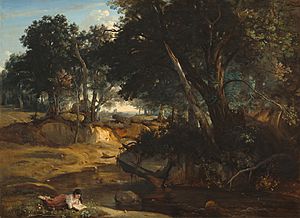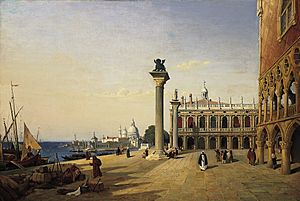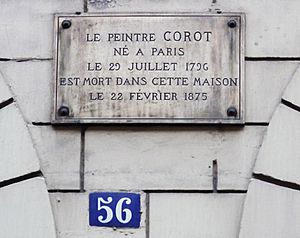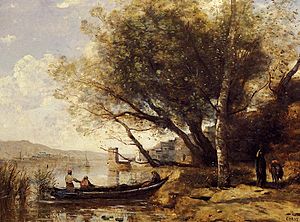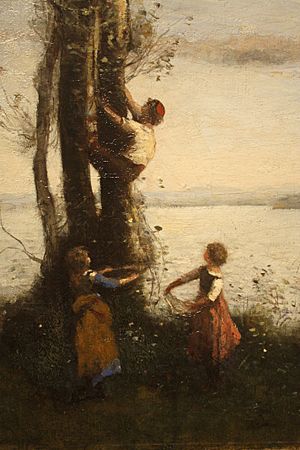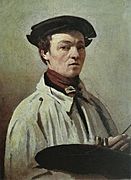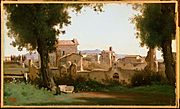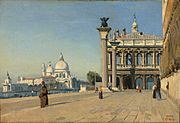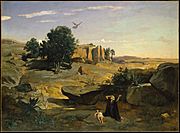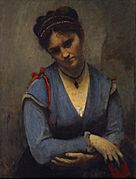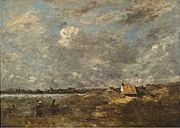Jean-Baptiste-Camille Corot facts for kids
Quick facts for kids
Jean-Baptiste-Camille Corot
|
|
|---|---|
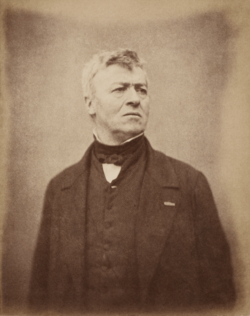
Portrait of Corot circa 1850
|
|
| Born |
Jean-Baptiste-Camille Corot
July 16, 1796 Paris, France
|
| Died | February 22, 1875 (aged 78) Paris, France
|
| Known for | Painting, printmaking |
| Movement | Realism |
| Signature | |
Jean-Baptiste-Camille Corot (born July 16, 1796 – died February 22, 1875), often called Camille Corot, was a famous French painter. He is best known for his beautiful landscape paintings and also painted portraits. Corot was also skilled in printmaking, especially etching. He was a very important artist in landscape painting. His work looked back to older styles like Neo-Classicism but also hinted at new ideas like painting outdoors, which later became popular with Impressionism artists.
Contents
Biography

Early Life and Learning to Paint
Jean-Baptiste-Camille Corot was born in Paris, France, on July 16, 1796. His family was quite well-off. His father was a wig maker, and his mother, Marie-Françoise Corot, owned a successful hat shop. Unlike many artists, Corot never had to worry about money. His parents were good at business and made smart investments.
Corot went to school in Rouen but found it difficult. He wasn't a great student and didn't show much interest in art until he was about 19. He was a shy and awkward young man. When he was 21, he moved into a room in his parents' new home, which became his first art studio.
His father first wanted him to work in the fabric business. Corot really disliked it, calling it "business tricks." But he stayed there until he was 26. Finally, his father agreed to let him become an artist. Corot said he told his father that business and he "were simply incompatible." However, working with fabrics might have helped him develop an eye for colors and textures. Around 1821, he started oil painting, focusing on landscapes right away. In 1822, he began receiving money from his family. This allowed him to pay for his studio, art supplies, and travel for the rest of his life.
At this time, landscape painting was becoming very popular. There were two main styles:
- Historical landscape: This style, common in Southern Europe, showed perfect views of real or imagined places. It often included figures from ancient stories or the Bible.
- Realistic landscape: This style, more common in Northern Europe, showed actual places, buildings, and plants. It often included everyday people like farmers.
Artists usually started by sketching outdoors and then finished their paintings inside. English painters like John Constable and J. M. W. Turner greatly influenced French artists. They helped move painting away from the old Neoclassical style towards more realism.
For a short time, Corot studied with Achille Etna Michallon, a landscape painter. Michallon taught Corot to draw and paint outdoors. Corot practiced in forests, by the sea, and in villages near Paris. Michallon also taught him about the French Neoclassical style. This style aimed to show ideal beauty in nature, often linked to ancient events. Corot later said that Michallon taught him to paint "with the greatest scrupulousness everything I saw before me."
After Michallon died in 1822, Corot studied with Jean-Victor Bertin. Bertin was another famous Neoclassical landscape painter. Corot learned to draw plants precisely. Even though he respected the Neoclassical style, Corot also drew real things like tree trunks and rocks. This showed the influence of Northern realism. Throughout his career, Corot often combined both styles in his art.
First Trip to Italy
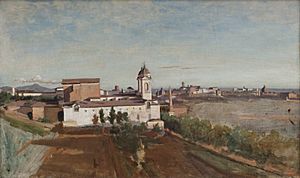
With his parents' support, Corot went to Italy from 1825 to 1828. Many French painters did this to study old masters and draw ancient Roman ruins. Before he left, his parents asked him to paint a self-portrait, which was his first. Corot's time in Italy was very important for his art. He created over 200 drawings and 150 paintings there. He worked with other young French painters, painting together and discussing their art.
Corot didn't learn much from the famous Renaissance masters. Instead, he spent most of his time around Rome and in the Italian countryside. He often visited the Farnese Gardens to paint its views of ancient ruins. This trip helped him understand how to paint landscapes with depth and how to place buildings naturally. He also learned to make buildings and rocks look solid using light and shadow. Adding figures to his landscapes was also important to show human scale and context. He worked on drawing people for this reason.
The bright Italian sun was a challenge for him. He said, "This sun gives off a light that makes me despair." But he learned to master the light and paint stones and sky with subtle changes. Corot was also impressed by Italian women. He wrote about his strong commitment to painting: "I have only one goal in life that I want to pursue faithfully: to make landscapes."
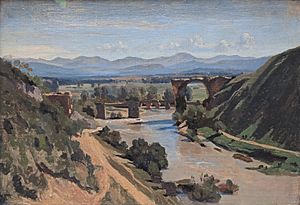
Aiming for the Salon
After his first trip to Italy, Corot spent six years preparing large landscapes for the Salon. The Salon was the most important art exhibition in France. Many of his Salon paintings were based on his Italian sketches. He would rework them in his studio, adding formal elements to fit Neoclassical rules. For example, his first Salon painting, View at Narni (1827), changed a quick outdoor sketch of a Roman aqueduct into a perfect, peaceful scene with large shade trees. He did this to please the Neoclassical judges. Many people today value his outdoor Italian paintings more because they show early signs of Impressionism. They are true to natural light and avoid strict academic rules.
Decades later, Impressionism changed art by using a similar approach: quick, spontaneous painting done outdoors. However, Impressionists used bright, unmixed colors to capture light. Corot usually mixed his colors to create soft, dreamy effects.
When he wasn't in his studio, Corot traveled around France, painting rustic landscapes. He visited the Normandy coast and Rouen, where he lived as a child. Corot also painted portraits of friends and family. His sensitive portrait of his niece, Laure Sennegon, is one of his most famous. He often made two copies of family portraits and sometimes of his landscapes too.
In 1829, Corot began painting in the Forest of Fontainebleau near Barbizon. He returned there several times and met artists from the Barbizon school, including Théodore Rousseau and Jean-François Millet. Corot showed portraits and landscapes at the Salon in 1831 and 1833. The critics weren't very impressed, so Corot decided to go back to Italy.
Mid-Career Success
Corot made two more trips to Italy, visiting Northern Italy, Venice, and the Roman countryside again. In 1835, his biblical painting Agar dans le desert (Hagar in the Wilderness) caused a stir at the Salon. It showed Hagar and Ishmael dying of thirst until an angel saved them. This painting was a bold Neoclassical work that impressed critics. He painted other biblical and mythological scenes, but they weren't as successful.
Through the 1840s, Corot still had problems with critics. Many of his works were rejected from the Salon, and not many were bought by the public. However, by 1845, the writer Charles Baudelaire praised Corot as a leader in modern landscape painting. While some critics found Corot's colors "pale," Baudelaire said Corot was more of a "harmonist than a colorist." He admired Corot's simple colors and compositions.
In 1846, the French government gave him the cross of the Légion d'honneur. In 1848, he won a second-class medal at the Salon. But he didn't get much support from the government. His only official commission was a religious painting in 1847. Other painters, like Eugène Delacroix, began to recognize Corot's talent. Delacroix called him a "true artist." After the Revolution of 1848, Corot's public image greatly improved. He became a member of the Salon jury and was promoted in 1867.
Corot remained very close to his parents, even in his fifties. After they passed away, he gained more freedom to travel and teach. He took on students, including the future Impressionist Camille Pissarro. Corot's energy and advice impressed his students. Charles-François Daubigny called him "a wonderful man." Another student said Corot was "very amusing" and would sing opera songs.
By the mid-1850s, Corot's more impressionistic style started to gain recognition. From then on, he painted many "souvenirs" and "paysages." These were dreamy, imagined paintings of places he remembered, painted with light, loose brushstrokes.
Later Years
In the 1860s, Corot still mixed peasant figures with mythological ones in his paintings. This blended Neoclassicism with Realism. One critic wished he would replace his nymphs with peasants. In his later life, he did paint more human figures and fewer nymphs.
Corot's studio was often full of students, friends, and collectors. He was very successful, with his paintings selling for high prices. With his success, Corot became very generous with his money and time. He was seen as a respected elder in the art community. He used his influence to help other artists get commissions. In 1871, he gave money to the poor of Paris during the Franco-Prussian War. In 1872, he bought a house for Honoré Daumier, another artist who was blind and homeless. In 1875, he gave money to the widow of Jean-François Millet to support her children. His kindness was well-known. He also supported a day center for children in Paris. Even with great success, he remained humble and modest. He believed that "men should not puff themselves up with pride."
Despite his success, many friends felt he was not officially recognized enough. In 1874, shortly before he died, they gave him a gold medal. Corot died in Paris at age 78 from a stomach illness. He was buried at Père Lachaise Cemetery.
Many artists called themselves Corot's students. Some of the most famous include Camille Pissarro, Eugène Boudin, and Berthe Morisot.
Art and Technique

Corot is a key figure in landscape painting. His work connects the old Neo-Classical style with the new outdoor painting of Impressionism. Claude Monet, a famous Impressionist, once said, "There is only one master here—Corot. We are nothing compared to him." Corot's paintings of people are also very important. Edgar Degas preferred Corot's figures to his landscapes. Even Pablo Picasso was influenced by Corot's classical figures.
Historians often divide Corot's work into different periods. But these periods can be blurry because he sometimes finished paintings years after he started them. In his early years, he painted in a traditional, "tight" way. This meant using exact details, clear outlines, thin brushstrokes, and precise definitions. After he turned 50, his style changed. He focused more on overall tone and used thicker paint to create a poetic feeling. About 20 years later, from around 1865, his painting became more lyrical and impressionistic. His brushstrokes became more visible, and he focused even more on tone. This change shows a shift from his early outdoor paintings, full of warm natural light, to his later studio landscapes, which had soft, silvery tones. In his last 10 years, he was known as "Father Corot" in Parisian art circles. He was loved and seen as one of the greatest landscape painters ever. In his long career, he painted over 3,000 pictures.
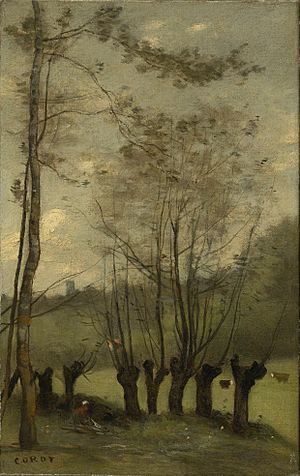
Even though he is seen as a forerunner of Impressionism, Corot painted landscapes more traditionally than people often think. Compared to the Impressionists who came later, Corot used a limited color palette. He often used browns and blacks (colors Impressionists avoided) and dark or silvery greens. While his paintings sometimes look quick and spontaneous, his brushstrokes were usually controlled and careful. His compositions were well-planned and kept simple to create a poetic effect. He said, "I noticed that everything that was done correctly on the first attempt was more true, and the forms more beautiful."
Corot's approach to his subjects was also traditional. Even though he loved painting outdoors, he was mainly a studio painter. Few of his finished landscapes were completed outside. For most of his life, Corot spent summers traveling, making sketches and studies. Then, in winter, he would finish more polished paintings in his studio to sell. For example, his painting Bathers of the Borromean Isles (1865–1870) refers to a lake in Italy, even though Corot hadn't been to Italy in 20 years. He focused on painting from his imagination and memory rather than direct observation. This was popular with the Salon judges, and he was a member of the jury.
In the 1860s, Corot became interested in photography. He took photos himself and met many early photographers. This made his painting colors even more muted, like the black-and-white tones of photographs. Some critics found his later work a bit boring because of this. Théophile Thoré-Bürger wrote that Corot "has only a single octave, extremely limited and in a minor key." Corot replied:
What there is to see in painting, or rather what I am looking for, is the form, the whole, the value of the tones...That is why for me the color comes after, because I love more than anything else the overall effect, the harmony of the tones, while color gives you a kind of shock that I don't like. Perhaps it is the excess of this principal that makes people say I have leaden tones.
Corot's dislike for "shocking" colors made him very different from the rising Impressionists, who loved experimenting with bright hues.
Besides his landscapes, Corot also created many valuable paintings of people. While some subjects were in peaceful outdoor settings, most were painted in his studio using live models. Like his landscapes, these figure paintings have a thoughtful, poetic feel. His later works like L'Algérienne (Algerian Woman) and La Jeune Grecque (The Greek Girl) are great examples. Corot painted about fifty portraits, mostly of family and friends. The colors in his figure paintings are usually soft but strong and pure. Corot also made many etchings and pencil sketches. He even experimented with a process called cliché verre, which mixes photography and engraving. From the 1830s, Corot also painted decorative panels and walls in his friends' homes, often with help from his students.
Around 1860, Corot summed up his approach to art: "I interpret with my art as much as with my eye."
Corot's works can be found in museums in France, the Netherlands, Britain, North America, and Russia.
Forgeries
Because Corot's paintings were very popular, especially his later style which was easier to copy, many fake Corot paintings were made between 1870 and 1939. Someone once joked that "Corot painted three thousand canvases, ten thousand of which have been sold in America." While this is an exaggeration, thousands of fakes do exist.
Corot himself was quite relaxed about copying. He allowed his students to copy his works and even borrow them. He would sometimes touch up and sign copies made by students or collectors. He also loaned his works to professional copiers and rental agencies. This made it easier for fakers to create copies that looked real. When experts tried to list all of Corot's original works, forgers used these lists to make their fake paintings even better.
Selected works
- The Bridge at Narni (1826), Musée du Louvre
- Venise, La Piazetta (1835), Musée du Louvre
- Le Baptême du Christ (1845–1847), Paris, Eglise Saint-Nicolas-du-Chardonnet
- Une Matinée, la Danse des Nymphes (1850), Musée d'Orsay
- Le concert champêtre (1857), Musée Condé, Chantilly
- Macbeth and the Witches (1859), Wallace Collection
- Baigneuses au Bord d'un Lac (1861), private collection
- Orpheus Leading Eurydice from the Underworld (1861), The Museum of Fine Arts, Houston
- Gitane au tambourin (1862), Botero Museum, Bogotá
- Meadow by the Swamp, National Museum of Serbia
- Vist of Castel Sant'Angelo, National Museum of Decorative Arts, Buenos Aires
- Souvenir de Mortefontaine (1864), Musée du Louvre
- L'Arbre brisé (1865)
- Ville d'Avray (1867), National Gallery of Art
- A Woman Reading (1869), Metropolitan Museum of Art, New York
- Nymphes et Faunes (before 1870), Birmingham Museum of Art, Alabama
- L'Albanese (1872)
- Pastorale—Souvenir d'Italie (1873), Glasgow Art Gallery
- Biblis (1875)
- Stream with a White Horse, Toledo Museum of Art
- Landscape (unknown), Bass-Dwyer Collection
Gallery
-
Self-portrait, c. 1835, Uffizi Gallery
-
View from the Farnese Gardens. 1826, The Phillips Collection
-
Morning in Venice. 1834, Pushkin Museum
-
Hagar in the Wilderness. 1835, Metropolitan Museum of Art
-
Portrait of Mariette Gambay (“La Songerie de Mariette”). 1869–1870, Pushkin Museum
-
Stormy Weather, Pas de Calais. c. 1870, Pushkin Museum
-
Sibylle, circa 1870, Metropolitan Museum of Art
See also
 In Spanish: Camille Corot para niños
In Spanish: Camille Corot para niños
- Effets de soir
- History of painting
- List of Orientalist artists
- Orientalism
- Western painting


